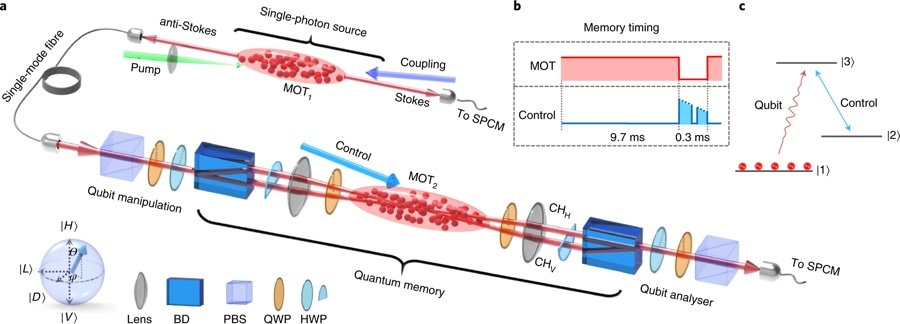Apr 29 2019
A new record in photonic quantum memory efficiency has been set by a joint research group of The Hong Kong University of Science and Technology (HKUST) and The South China Normal University (SCNU), thereby moving a step closer to turning quantum computation into a reality.
 Experimental set-up and energy level scheme of a single-photon quantum memory. (Image credit: The Hong Kong University of Science and Technology)
Experimental set-up and energy level scheme of a single-photon quantum memory. (Image credit: The Hong Kong University of Science and Technology)
Similar to memories in computers, quantum memories are components vital to quantum computers—a new class of data processors that are governed by the laws of quantum mechanics and with the ability to overcome the drawbacks of classical computers. They may extend the limits of basic science and help develop new drugs, give an explanation for cosmological mysteries, or improve the accuracy of forecasts and optimization plans with their vigorous computational power.
It is expected that quantum computers will become considerably faster and more robust compared to conventional computers since information is calculated in qubits—which, in contrast to the older units (bits) used in classical computers, have the ability to represent both 0 and 1 at the same instances.
Photonic quantum memories enable storage and retrieval of flying single-photon quantum states. Yet, the creation of considerably efficient quantum memories such as those is still very challenging since it mandates perfectly matched photon-matter quantum interface. At the same time, a single photon’s energy is very weak and could be easily lost in the noisy sea of stray light background. For many years, these drawbacks have inhibited quantum memory efficiencies to less than 50%—a threshold value critical for practical applications.
Currently, for the first time, a joint research group headed by Prof. DU Shengwang from the Department of Physics and William Mong Institute of Nano Science and Technology at HKUST; Prof. ZHANG Shanchao from SCNU who graduated his PhD study at HKUST; Prof. YAN Hui from SCNU and a former postdoctoral fellow at HKUST; as well as Prof. ZHU Shi-Liang from SCNU and Nanjing University, has discovered a new method to enhance the efficiency of photonic quantum memories to more than 85% with a fidelity of over 99%.
The researchers trapping billions of rubidium atoms into a very small, hair-like space to develop such a quantum memory—the atoms are cooled down to almost absolute zero temperature (about 0.00001 K) with the help of lasers and magnetic field. The researchers also discovered a brilliant method for differentiating the single photon from the noisy background light sea. The discovery has pushed the dream of a “universal” quantum computer one step closer to reality. Quantum memories such as these can even be used as repeaters in a quantum network, laying the foundation for a new class of quantum-based Internet.
In this work, we code a flying qubit onto the polarization of a single photon and store it into the laser-cooled atoms. Although the quantum memory demonstrated in this work is only for one qubit operation, it opens the possibility for emerging quantum technology and engineering in the future.
DU Shengwang, Professor, Department of Physics and William Mong Institute of Nano Science and Technology, HKUST
Recently, the outcomes of the study were published Nature Photonics, an authoritative journal, as a cover story of—the most recent one of a series of studies from Prof. Du’s laboratory on quantum memory, the first of which was started in 2011.